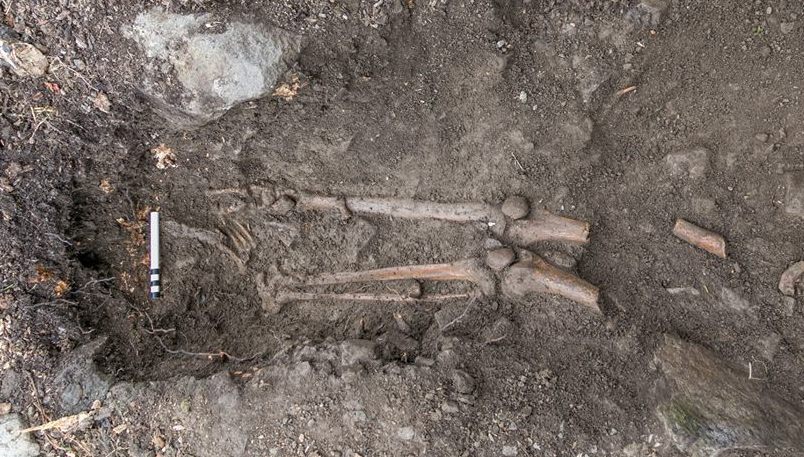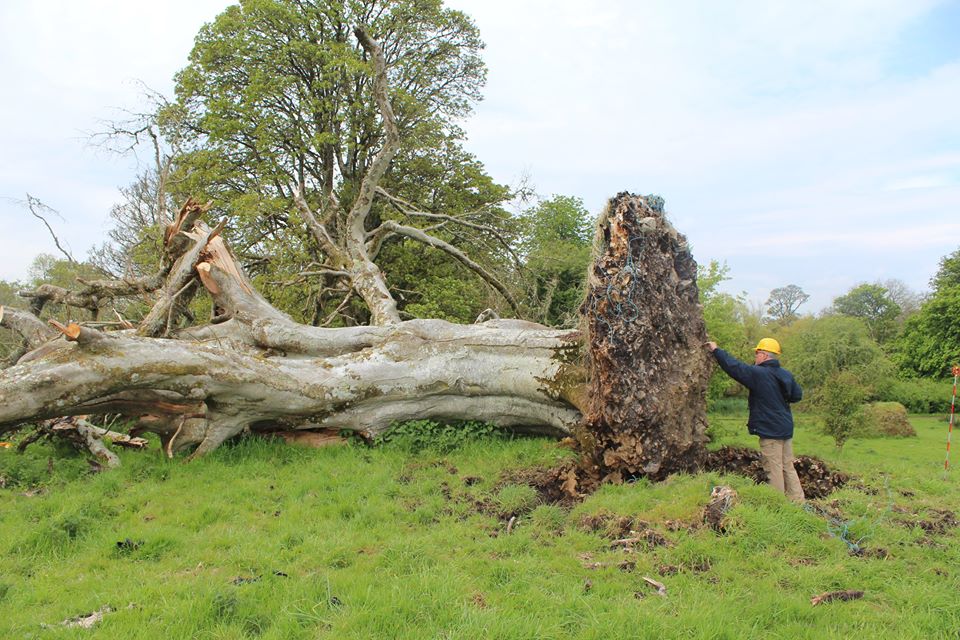
Interesting news from Collooney in Co. Sligo where archaeologists working for Sligo-Leitrim Archaeological Services (on behalf of the National Monuments Service) have discovered an early medieval skeleton in unusual circumstances. The body was identified earlier this year beneath a 200 year old beech tree that had blown down during a storm. Slightly bizarrely, the upper part of the skeleton was found raised in the air, within the tree’s up-turned root system, while the legs were still in the ground.

Preliminary analysis has indicated that the remains consist of young man who was between 17 and 25 years old when he died. His bones contained several injuries which had been inflicted by a sharp blade, possibly a sword or knife. He had obviously suffered a violent death, but whether these wounds were related to an ancient battle or a personal dispute remains unknown. The body was subsequently buried in a shallow east-west oriented grave and radiocarbon analysis indicates that this occurred sometime between 1030 and 1200 AD.
According to archaeologist Marion Dowd, ‘No other burials are known from the area but historical records do indicate a possible graveyard and church in the vicinity’. Post-excavation work for this site is still on-going and hopefully this will shed further light on this man and the nature of his death nearly 1000 years ago.



Right, where is the straight-on closeup photo of the upper skeleton among the roots? Article is Mmssing the mark without it 😉
Exactly, Nevvton.
Where is the picture with the red arrows pointing to all the various bones? I can’t even make out one bone past the spine in the video.
I was fascinated to read this – last year I published a novel The Emerald Comb, in which a beech tree blows over in a storm and a skeleton is discovered entangled in its roots… I’d done masses of research to make sure bones could survive a few hundred years under a tree. Was delighted to see my research vindicated.
Now writers everywhere are thinking, what a great idea for a book – but I got there first!
Cool!
Excellent plug for the book, Kathleen!
My first novel, The Eleven, is due out next spring; I will wait for an appropriate news splash and hit the stands at the same time.
Iny links? An how do I get your book?
Sorry, only just seen your reply to my comment. Here’s the link for Amazon – it’s ebook only I’m afraid but available on all ebook platforms.
http://www.amazon.co.uk/Emerald-Comb-Kathleen-McGurl-ebook/dp/B00N1XRS3K
A victim of the Vikings…..
17 to 25 years would be considered young for our times but 1,000 years ago would it not have been considered middle aged? Life expectancy couldn’t have been much more that 40 years back then?! He may have been killed defending his church from Norse raiders?
Dave, I have read that the life expectancy average is badly skewed by child mortality rates and rendered unrealistic. Once past infancy, most healthy people lived lives not a lot shorter than our own. It’s only with the advent of better nutrition, healthcare and dental care in the 20th Century that we began to live markedly longer. A 17-year-old was still a kid then as he is now.
Dave,
You are confusing average life expectancy with real life
expectancy.People have been living to their 70’s and 80’s for thousands of years. The only difference in ancient times was
how many didn’t survive childhood, plague or wars.I you were
not a victim of these you could reach a good old age.
According to the rumor mill, the victim was punished for owning a copy of “Ulysses.”